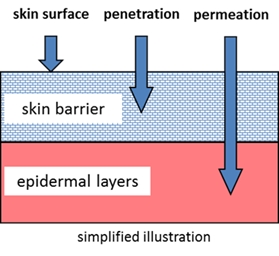If one enters the combinations of the keywords "cosmetic", "dermatology" and "medicine" into search engines, the result is currently an increasing hit rate in the order from 1 to 4.
- Cosmetic dermatology
- Cosmetic medicine
- Dermatological cosmetics
- Medical cosmetics
As the hit rate grows, so does the dominance of product advertising for cosmetics. This becomes particularly clear when switching to the image hits.
Not protected
The word combinations are neither protected nor defined. In the past, there have been various legal disputes because the terms were used in advertising in an unjustified or unfair manner or because the products were considered to be similar to medicinal products. Among other things, the "perception of the market" played a role in whether a cosmetic product is understood by the general public as a dermatological preparation. Another point of contention: The advertised dermatological property was not proven.
Cosmeceuticals with their biochemical evidence of efficacy and the corneotherapy founded by A. M. Kligman have influenced the attributes "dermatological" and "dermatologically effective" in skin care quite significantly in recent years. In short: Cosmetic compositions can have clinically verifiable effects. The decisive factors are their biophysical and biochemical properties, i.e. do they remain on the skin surface, do they penetrate or permeate and what reactions do they trigger on the spot?

Figure: Penetration and permeation
Penetrated and permeated (transdermal) cosmetic ingredients are metabolised and can exert their effect in living tissue – e.g. vitamin A is enzymatically converted into vitamin A acid and stimulates regeneration. Vitamins and their derivatives and terpenes from essential oils partly reach the bloodstream, are metabolised and finally excreted again as water and carbon dioxide besides degradation products in the urine. Transport agents such as liposomes (hydrophilic) and nanodispersions (lipophilic) primarily accelerate the penetration and, downstream, the permeation of cosmetic components.
Accordingly, transdermal cosmetic substances must be physiologically compatible and must not have a systemic effect (unlike medicinal products). Therefore, the EU Cosmetic Regulation requires a safety report for all cosmetics. The old thesis that cosmetics may only remain on the surface of the skin and not penetrate deeper therefore does not correspond to reality.
What does dermatologically effective mean?
A dermatological effect is, for example, the anti-inflammatory effect of a cream containing D-panthenol. Make-up or facial cleansing with water is not dermatologically effective. But be careful: Even washing (showering) with cold water leads to the release of adrenal hormones, which have a significant influence on the skin (tightening, increased microcirculation, stimulation of regeneration and the immune system). Often there is no "either or" ("black or white"), but smooth transitions with regard to dermatological effectiveness.
The EU Cosmetic Regulation accepts dermatologically active components and thus also dermatological cosmetics as well as their justifications by not prohibiting them. However, the EU Cosmetic Regulation does not accept any advertising claim that includes a soothing or healing effect or treatment, although e.g. D-panthenol, aloe vera and essential fatty acids have been proven to have a healing influence on inflammatory processes.
Medicinal substances such as clotrimazole and piroctone-olamine may also be used in cosmetics. In terms of advertising, the anti-dandruff effect, but not the antimycotic effect, may be advertised.
Dermatological optimisation
The data from in vitro studies on individual substances often come from the active ingredient suppliers. Much more important, however, are in vivo studies and clinical investigations, data from the scientific literature on individual substances and their combinations, and compliance with relevant active ingredient concentrations in the formulations. With the exclusion of cosmetic components that are approved but not sustainable and/or lead to undesirable side effects in the long term, formulations can be optimised in the dermatological sense.
One example is preservatives, which can trigger allergies and the development of resistance within the skin microbiome (cf. antibiotics). Counterproductive are also occlusive formulations that reduce the regenerative activity of the skin.
Cosmeceuticals are comparatively well documented and focus on biochemical evidence of efficacy. However, cosmeceuticals are also not defined in the EU Cosmetic Regulation or in the pharmaceutical legislation, and not all studies on the individual substances are really robust.
In its original form, Albert M. Kligman's corneotherapy uses cosmetic compositions to restore the skin barrier. This influences and ends recurrent processes inside the epidermis. By their nature, these treatments take longer than medicines, but have the advantage of being long-lasting and without the inevitable side effects of medicines.
Barrier disorders in the course of atopic dermatitis respond particularly well to corneotherapy. Cornification disorders and dermatoses can also be successfully treated with adjuvant cosmetic therapy.
Even basic substances such as lipids and film formers can have an effect. Further examples:
| Indication |
Medicinal substances |
Adjuvant cosmetic active ingredients |
| Hormone treatment |
Oestrogens |
Isoflavonoids |
| Atopic skin |
Corticoids |
Barrier-active substances |
| Acne |
Retinoids: tretinoin, isotretinoin |
Vitamin A, essential fatty acids, azelaic acid |
| Rosacea |
Antibiotics |
Protease inhibitors, essential fatty acids, azelaic acid |
| Inflammation |
Antibiotics |
Protease inhibitors, essential fatty acids |
| Itching |
Antihistamines |
Urea, allantoin, endocannabinoids |
By means of physiologically compatible penetration enhancers, the skin barrier can be specifically adjusted to permeability and with lamellar phosphatidylcholine-containing cream bases to protection – which is of great practical importance for the transport of active ingredients and natural skin protection. The term extended corneotherapy, among others, was coined for this treatment technique.
Conclusion
Dermatological cosmetics are sustainable skin care. It consists of components that are physiologically compatible, biodegradable and do not alter the skin microbiome a minimum. Physiological (dermatological) skin care leads to clinically significant effects in dermatological indications.
Literature: Korneotherapie – Bindeglied zwischen Dermatologie und Kosmetik, 1. Auflage, Deutscher Apotheker Verlag, Stuttgart 2022, ISBN 978-3-7692-7893-4
Dr Hans Lautenschläger | 
